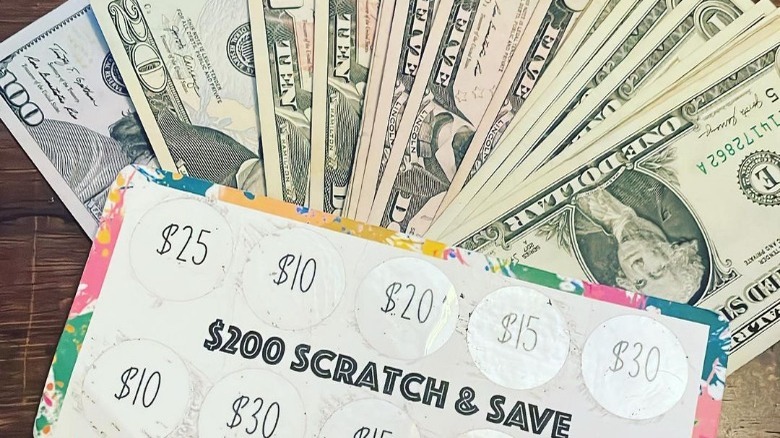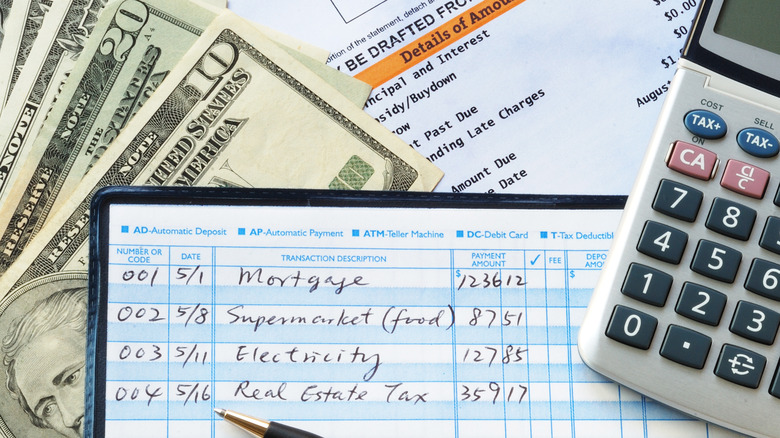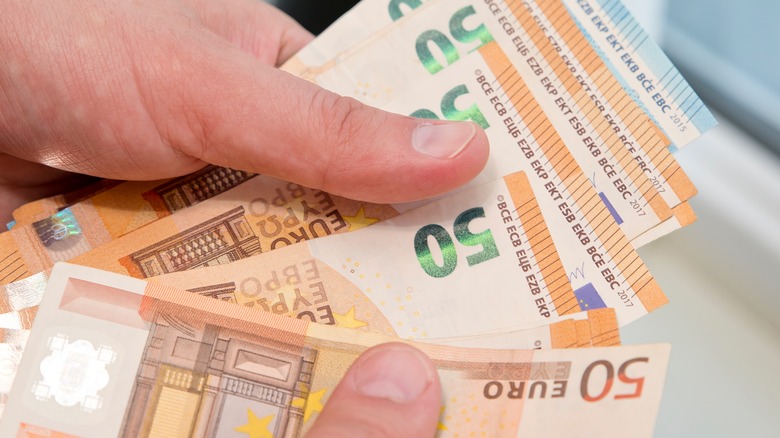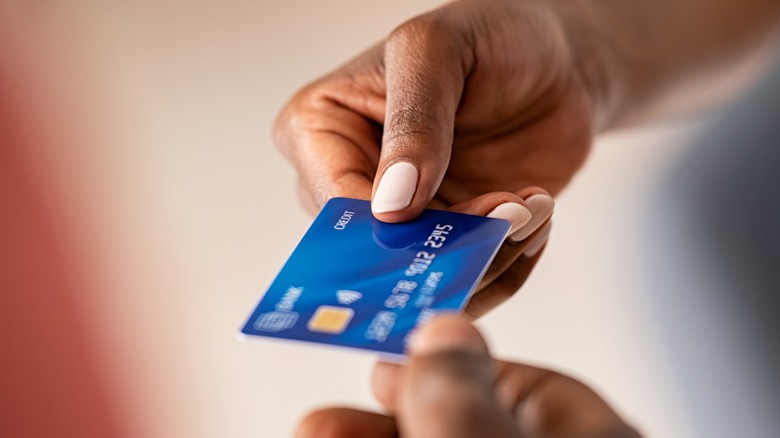The TikTok-Viral Cash Stuffing Trend May Finally Be A Solution To Overspending
Despite its ever-increasing popularity in recent years, the video-sharing platform TikTok often gets a bad rap — from hazardous challenges to unregulated life hacks to political censorships. While TikTok can be rife with meaningless information, it's still a treasure trove of fresh, pre-digested content and a powerful tool for transformative education. This is especially true for the Gen Z cohort, who make up 60% of TikTok users, per Fanbytes. If you're in luck, you'll bump into life hacks that can be surprisingly helpful in real life. And cash stuffing — a hack that teaches people how to spend less and save more — is one of them.
On TikTok, searches for the cash stuffing hack have reached 216.9 million views at the time of writing. Don't discount the impact of this money-saving trend just because it's popular with Gen Z. Contrary to popular belief, Gen Z are more financially savvy than most of us give them credit for. With living expenses going up and financial strife remaining the top concern for many, it's not a bad idea to look for a new technique to minimize impulsive spending and maximize savings. Below, check out how you can use the TikTok-viral cash stuffing trend to master discretionary spending and pay off your debts faster.
How cash stuffing works
Turns out, this money-saving trend that's been taking TikTok by storm is pretty manual, much like the record-keeping practices of previous generations. As a TikTok user who goes by the handle @monets_money shows us in their video, cash stuffing is a technique in which you physically budget and store your money rather than using a digital service to do the job. In the video, a person takes out a stack of notes and crams them into separate envelopes labeled with categories like "groceries," "savings," and "gifts." No fancy e-banking device or complicated spreadsheet is involved in the budgeting process. The rationale behind this method is that when you physically count the amount of money you have and take time to budget, you'll be less likely to use your cash for the wrong purpose and spend beyond your means.
The reason why this old-school hack is trending again is that it goes right to the root of the problem: the availability of digital wallets. A report from business consulting firm Bain & Co. (via Retail Dive) reveals that mobile payment users spend twice as much as those who don't. In the age of digital spending, it's easy to lose sight of how much you actually have and end up overspending. Having increased awareness and discipline of spending will force you to think twice before using money and help you stay on top of your finances.
Cash stuffing has worked for many people
If you wonder whether cash stuffing is just a freshly discovered TikTok fad, the answer is no. Long before the advent of technology or TikTok, cash stuffing was the go-to money-keeping method for many families who swear by spending no more than the amount they put aside for each category.
Credello conducted an online poll of 600 people who had used cash stuffing in the past and discovered that roughly 61% of respondents use cash stuffing on a regular basis to manage their finances. After receiving their paychecks, over 45% of respondents budget and spend their money according to the cash stuffing method. One in three people believes the cash-stuffing budgeting method is a great tactic for saving toward a goal. Additionally, the poll found that cash stuffing is used by 28.26% of Millennials and Gen Zers for day-to-day purchases.
Commenting on the benefits of cash stuffing, investor Harry Turner tells GOBankingRates: "Cash stuffing is a financial strategy that involves saving cash instead of investing it in order to best inflation. This strategy is especially popular with Gen Z...who are often saddled with student debt and uncertain job prospects. So by stashing away cash, they hope to safeguard their finances against an uncertain future."
How to get started on the cash stuffing trend
To start your cash-stuffing journey, you first need to create, "a budget for yourself and what you could realistically afford to put away each month," Isobel Lawrance, assistant content editor at MoneyMagpie told Bustle. Consider the necessities such as household bills, groceries, education, and transportation, as well as the amount of money you plan to spend for special occasions such as birthdays, vacations, or self-treats. What is left is how much you can put into your savings.
After getting your paycheck, withdraw your money, allocate the bills as per your budgeting plan, and stuff them into envelopes labeled for each category. If you've spent all the cash in a specified envelope, you'll have to wait until your next cash-stuffing session or your next paycheck to spend into that category again. "I had to keep track of every penny to break even by the end of each month, and this method came in handy," consumer finance lawyer Lyle Solomon tells U.S. News & World Report. "So, cash stuffing may be trending now, but the method itself is old, and I can say it's really effective." The efficacy of this method has a lot to do with self-discipline. There will be some getting used to initially, but once you see how it benefits you, cash stuffing will become second nature.
The drawbacks of cash stuffing
There's no doubt that cash stuffing can change your spending habits for the better, but it's not without drawbacks. It's not safe to carry cash around or keep them in envelopes all the time, Bankrate warns. If the envelopes are stolen, there's almost zero possibility you'll be able to get them back. Besides, going to a bank to take out stacks of cash, separating them bill by bill, and stuffing the notes into different categories can be super time-consuming.
It's also worth pointing out that you could be missing out on potential interest earnings if you keep your money outside of the bank, Paragon Bank points out. Not to mention, most major transactions nowadays involve cards or e-banking transfers and certain purchases dictate restrictions on cash transactions. If you follow this method, it's important to leave a decent amount of money in your bank account so you can handle transactions that can not be done in cash. Therefore, it is advised that the cash-stuffing budgeting method be used primarily for short-term savings and minor spending as long-term savings are better kept in an account that pays interest.
Alternatives to cash stuffing
Aside from cash stuffing, there are a number of time-honored ways to help you rein in your spending. A piggy bank is a tool that many parents use to teach their children the power of saving. In fact, it's a simple yet effective saving method that many adults can benefit from. The idea behind piggy banking is that saving extra change can go a long way, and multiple modest deposits adding up over time can become a pension pot that you can use for big purchases, according to PointCard.
If you prefer a more protected money-saving method, consider opening three separate bank accounts for different types of expenses, certified financial planner Cynthia Meyer told Insider. This method is similar to the cash-stuffing method — but conducted on a digital platform. For instance, one bank account should be set aside for fixed monthly expenses, one account for emergencies, and one for annual expenses such as vacations. Another way to get off the cycle of mindless spending is to stop using credit cards and instead, get into the habit of using debit cards or cash to pay for everyday transactions.





